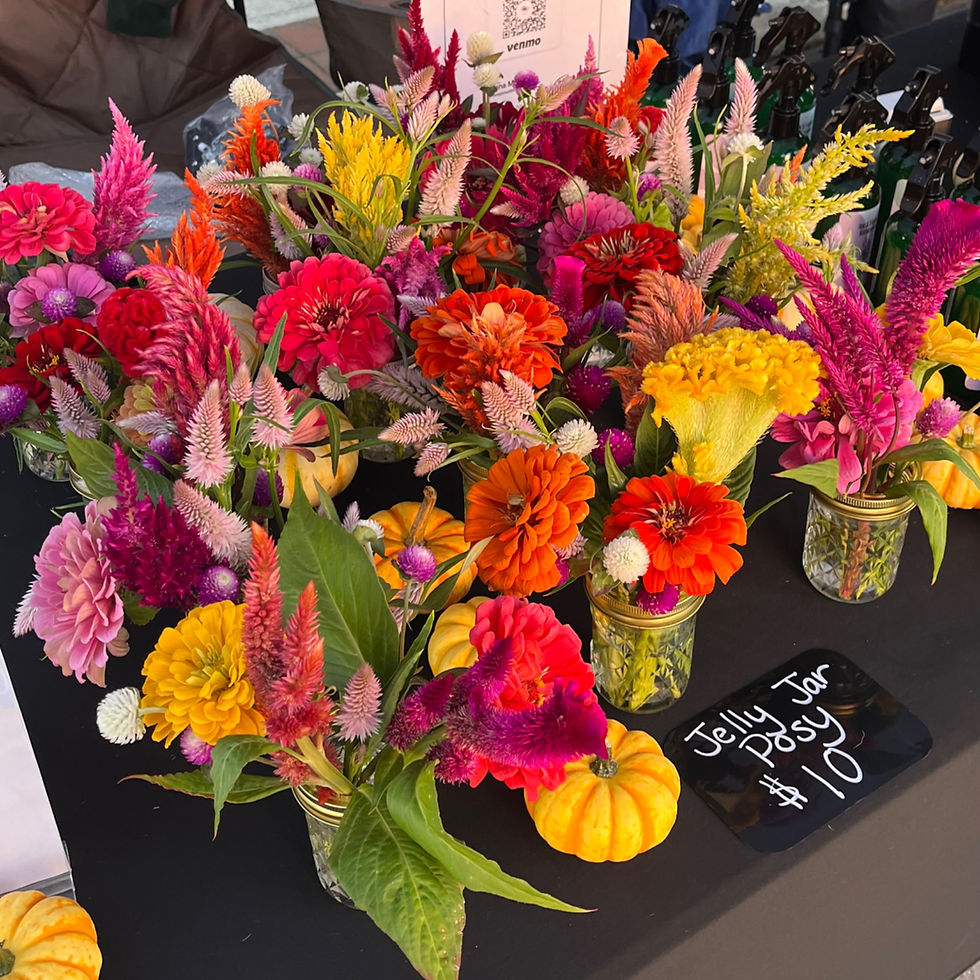Growing and Caring for Dahlias: Your Guide to Gorgeous Blooms
- handpickedblossoms

- 13 minutes ago
- 3 min read

There’s just something magical about dahlias—their bold colors, endless shapes, and dramatic presence make every garden (and bouquet) feel like a celebration. Sure, they have a shorter vase life than some flowers, but we promise—they’re totally worth it! Whether you’re a seasoned gardener or just dipping your toes into growing dahlias, here’s how we care for them, inspired by Floret’s fabulous dahlia guide.
Sourcing Bulbs or Seeds: Your Chance to Create a One-of-a-Kind Dahlia
Most gardeners start with tubers, which are easy to plant and give reliable blooms. But here’s where it gets fun: growing dahlias from seed means you’re basically a flower inventor! Each seed is a complete surprise—no two are alike—and you get the joy of naming your brand-new creation. Imagine watching a tiny seed turn into a show-stopping bloom you get to call your own. 🌸
When picking tubers, look for firm, healthy ones without signs of rot or shriveling. The happier your tuber, the happier your garden!
Planting and Fertilizing: Setting Your Dahlias Up for Success
Dahlias love sun, sun, and more sun. Plant them after the last frost in well-draining soil. Dig a hole about 6–8 inches deep, lay your tuber horizontally with the eyes facing up, and gently cover it with soil.
Fertilizer is their favorite snack: a light dose of low-nitrogen fertilizer at planting helps roots grow strong, and a balanced fertilizer every few weeks keeps those blooms coming. Think of it as a little spa treatment for your plants!
Cut-and-Come-Again: Because You Can Never Have Too Many Flowers
Dahlias are perfect for the “cut-and-come-again” approach. Snip blooms regularly, and the plant will reward you with even more flowers. Pro tip: cut stems in the morning or evening when the flowers are hydrated, and handle them gently—they’re delicate but fabulous!
To get long, strong dahlia stems, cut your blooms low on the plant—even if it feels counterintuitive! Cutting low encourages the plant to branch, producing more stems and more flowers, so your garden (and your vase) stays full of gorgeous blooms all season long.

Overwintering in Zone 7b: Keeping Your Dahlias Cozy
In Zone 7b, the first frost is your cue to start preparing for winter. When the foliage blackens, carefully dig up your tubers, shake off excess soil, and store them in a cool, dry, frost-free spot—using pine shavings helps keep them protected and dry. Some gardeners prefer to leave their tubers in the ground with a thick layer of mulch, which has the added benefit of encouraging plants to bloom earlier in the summer. Lifting tubers, however, usually prevents rot and ensures a strong start next season.
Dividing Tubers: Double the Fun
Want to enjoy even more dahlias next year? Dividing your tubers is the key! After lifting your tubers for the winter, gently separate the clumps into individual tubers. Each division should have at least one “eye” (growth bud), which is where new shoots will emerge in the spring.
Dividing tubers not only prevents overcrowding in the soil but also keeps your plants healthy and vigorous, encouraging larger, more abundant blooms. Handle each tuber carefully to avoid bruising, and store them in a cool, dry place until it’s time to plant.
Think of it as multiplying the joy of your garden—more tubers mean more plants, more flowers, and more color next season. With just a little effort now, your summer garden will be bursting with dahlias like never before!
Growing and Caring for Your Dahlias: A Flower Worth Every Second

Yes, dahlias have a shorter vase life than some flowers, but the color, texture, and drama they bring make every moment worth it. From garden beds to centerpieces, their beauty is unforgettable. To help your dahlias last longer in a vase, cut the stems early in the morning when they’re fully hydrated, remove any leaves that would sit below the water line, and place them in fresh, room-temperature water. Changing the water every 1–2 days and recutting the stems slightly each time keeps blooms vibrant longer!
We’d love to see your dahlia creations—what’s your favorite variety? Drop it in the comments and share the love!




Comments